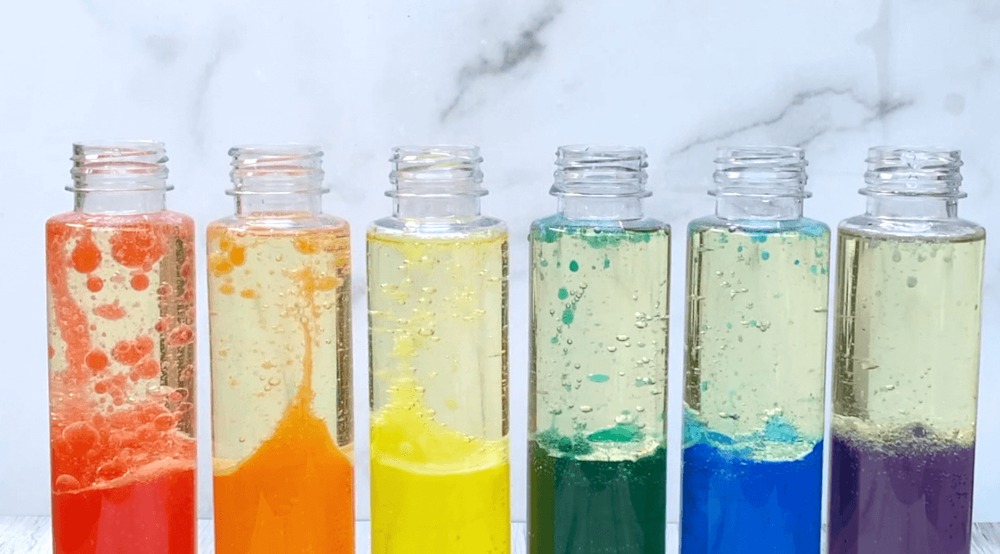Three Fun Halloween Experiments to do at Home
With Halloween right around the corner, what better time to do some spooky and fun science experiments! All three of these experiments can be done at home using common household items. Look below for the procedures and an explanation of why it works!
Lava lamps
Supplies:
Tall bottle, like an empty 1 liter bottle
Vegetable oil
Food coloring
Alka-seltzer tablet, cut into half
Procedure:
Add about an inch of water to the bottom of the bottle
Add 5 drops of food coloring
Fill the bottle about ¾ full with vegetable oil
Add one piece of the alka-seltzer tablet. Watch the reaction!
What happened?
Oil and water molecules will not mix because of their polarity. Water is a polar molecule, meaning that the electrons in the water molecules are shared unequally, resulting in a negative charge. Oil is a nonpolar molecule, meaning that the electrons in the oil molecules are shared equally, resulting in no charge. This causes the water molecules and oil molecules not to interact. And, since oil is less dense than water, the oil will form a layer on top of the water.
When the Alka-seltzer tablet is added, it reacts with the water, but not the oil. This chemical reaction produces carbon dioxide gas, which is less dense than both water and oil. So, the carbon dioxide will travel up in bubbles, taking some of the food coloring with it. At the top, the bubble bursts, and the food coloring will sink back down to the bottom of the bottle.
More with lava lamps:
Use different temperatures of water to compare the speed of the chemical reactions.
Try different sized pieces of the Alka-seltzer tablet
Adapted from: https://www.sciencebuddies.org/stem-activities/make-a-lava-lamp?from=Blog
Growing Gummy Bears
Supplies:
Gummy bears or other gummy candy
Three bowls
Water
Salt
Sugar
procedure:
In the first bowl, add one cup of water
In the second bowl, add one cup of water and seven tablespoon of salt
In the third bowl, add one cup of water and seven tablespoon of sugar
Measure length and/or weight the gummy bears, then place them in the bowls
Wait at least 4 hours or overnight, then measure the gummy bears again. Observe what happens!
what happened?
There’s a process called osmosis, where water moves across the membrane. The water can move across the membrane, but salt and sugar cannot. The water will “want” to move to the higher concentrated area to try and balance out the equilibrium. When the gummy bear is in the water, the water will move into the gummy bear because there is more sugar inside of the gummy bear than outside. However, in the salt water, the water will move out of the gummy bear because the salt will dissolve easier in water, causing a higher concentration. Finally, in the sugar water, the water moves into the gummy bear, but not as much as the plain water. This is because there is a higher sugar concentration inside the gummy bear, but it takes less water to make the solution balanced.
Growing Rock Candy
Supplies:
Granulated sugar
Water
Food coloring
Mason jar or other container to hold the rock candy
Sticks to grow the candy on
Clothes pins/chip clips/binder clips → the candy cannot touch the bottom!
procedure:
Dip the sticks in water, then coat in granulated sugar. Let them sit at least an hour to dry
With an adult, boil 1 cup of water. Once boiling, add in 2 cups of sugar. Stir until it is completely dissolved. Let it simmer for about 5 minutes, then cool for about 15 minutes.
Add to the bottom of your container and add your food coloring.
Attach a clothes pin to the skewer, let it hang into the jar. It should not touch the bottom, leave about an inch of room.
Wait about one week. Monitor the progress of your crystals!
Eat your rock candy!
what happened?
The sugar only dissolved in the water because it was boiling. This happened because the solubility increased, meaning that the sugar was able to be dissolved more easily with the higher temperature. Once the water cooled down, the sugar precipitated, or came out of the solution. With the pre-coated stick, the sugar molecules had something to latch on to. As the days go on, the water begins to evaporate, making the concentration of the sugar water increase, causing the sugar to continue to precipitate out, increasing the size of the crystals.
Adapted from: https://wearenotmartha.com/make-your-own-rock-candy/


